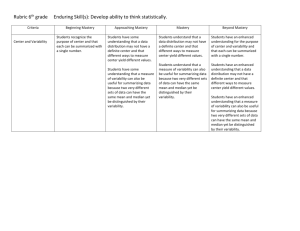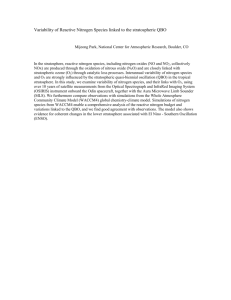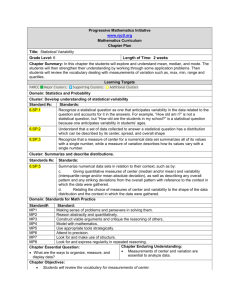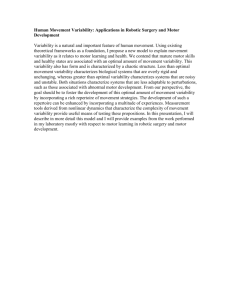Distinguishing Climate Change from Natural Variability in the
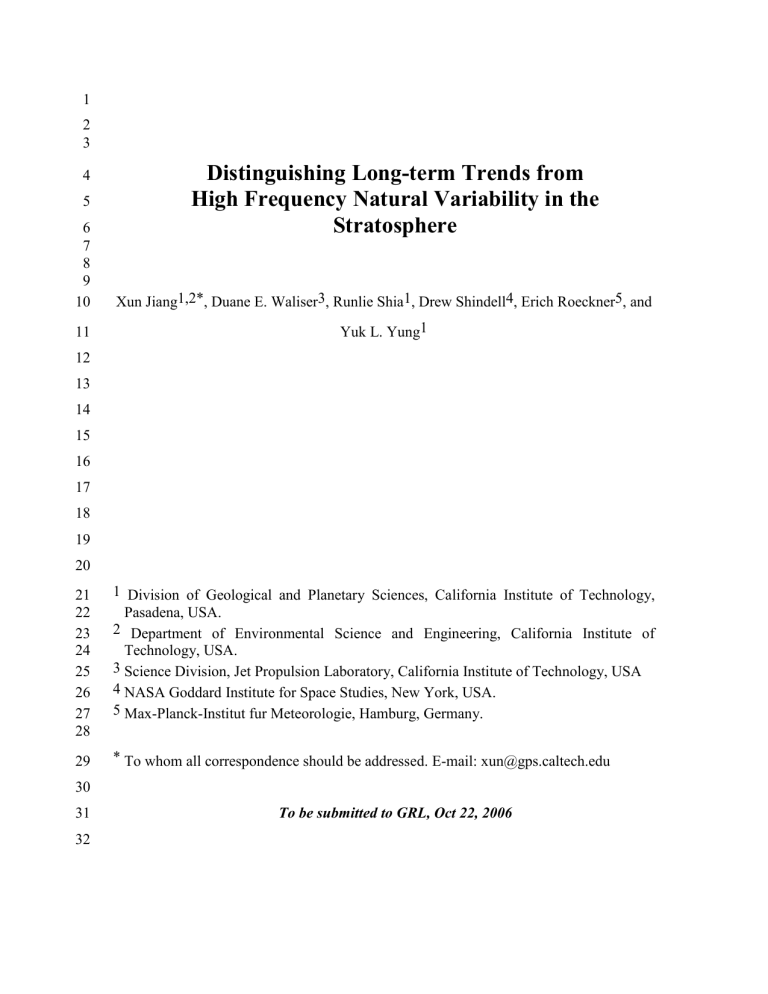
11
12
13
14
15
16
17
18
19
20
25
26
27
28
21
22
23
24
6
7
8
9
10
4
5
29
30
31
32
1
2
3
Distinguishing Long-term Trends from
High Frequency Natural Variability in the
Stratosphere
Xun Jiang1,2*, Duane E. Waliser3, Runlie Shia1, Drew Shindell4, Erich Roeckner5, and
Yuk L. Yung1
1 Division of Geological and Planetary Sciences, California Institute of Technology,
Pasadena, USA.
2 Department of Environmental Science and Engineering, California Institute of
Technology, USA.
3 Science Division, Jet Propulsion Laboratory, California Institute of Technology, USA
4 NASA Goddard Institute for Space Studies, New York, USA.
5 Max-Planck-Institut fur Meteorologie, Hamburg, Germany.
* To whom all correspondence should be addressed. E-mail: xun@gps.caltech.edu
To be submitted to GRL, Oct 22, 2006
12
13
14
15
10
11
8
9
6
7
4
5
1
2
3
16
Abstract
In this paper, we apply principal component analysis to observations and global climate model simulations to investigate the variability of stratospheric temperature. We reveal that most (~76%) of the interannual variability (IAV) of temperature in the northern hemisphere throughout the year can be characterized by the first four principal modes.
The cooling trend in the stratosphere is associated with a spatially uniform pattern of stratospheric variability, which is isolated from other higher-frequency modes of natural
IAV such as the Northern Annular Mode (NAM). These results are supported by a number of coupled ocean-atmosphere climate model simulations of the 20 th
century that were contributed to the International Panel on Climate Change’s 4 th
Assessment Report.
Given the spatial uniformity of the increased GHG forcing, this separation and identification of a spatially uniform stratospheric temperature response is not only plausible but might be expected and provides a simple yet useful test for global climate models used for projecting global warming.
21
22
23
24
17
18
19
20
13
14
15
16
9
10
11
12
25
26
27
28
7
8
5
6
3
4
1
2
29
30
1. Introduction
[1] A robust result associated with global warming of the surface and the troposphere is a concomitant cooling of the stratosphere [ Manabe and Wetherald , 1967; Ramaswamy et al.
, 2001; Ramaswamy et al.
, 2006]. However, it is typically very hard to separate the temperature trend due to the anthropogenic forcing from high frequency interannual variability (IAV). Satellite and radiosonde data have been used to study the zonal mean temperature trend in the stratosphere, and indicate a cooling trend (~0.6 k/decade) of global annual mean lower stratosphere [ Ramaswamy et al ., 2001]. The cooling trend increases with height. In the northern hemisphere mid-latitude, the lower stratospheric temperature has a trend ~0.75 k/decade over the period of 1979 to 1994. The cooling trend is large in the polar lower stratosphere, but it is hard to determine the significance of the trend due to the large IAV [ Shine et al ., 2003; Ramaswamy et al ., 2001].
[2] Model simulations indicate that the depletion of lower stratospheric ozone and increasing of well-mixed GHS are the major contributions to the stratospheric cooling trend [ Hansen et al.
, 1995; Rosier and Shine , 2000; Shine et al ., 2003; Ramaswamy et al .,
2006]. In addition, water vapor also has important contribution to the stratospheric cooling [ Forster and Shine , 1999]. In this paper, we apply an innovative approach to observations to separate the temperature trend from high frequency IAV. The results will be compared with a number of coupled ocean-atmosphere climate model simulations of the 20 th
century that were contributed to the International Panel on Climate Change
(IPCC) 4 th
Assessment Report. These issues, along with the fidelity of present-day model representations of polar stratospheric temperature variability, are discussed in conjunction with their implications for detecting and predicting climate change and its consequences.
2. Method and Data
[3] To extract the spatio-temporal patterns of stratospheric temperature IAV, we apply principal component analysis (PCA) [ Preisendorfer , 1988; Camp et al ., 2003] to the deseasonalized and area weighted monthly mean temperature data (
) at 50 hPa from Jan
1958 to Dec 1999, on a 2
2
latitude-longitude grid from 10
to 90
N. The data from Jan
7
8
5
6
3
4
1
2
9
20
21
22
23
24
25
26
10
15
16
17
18
11
12
13
14
19
1958 to Dec 1999 are from NCEP/NCAR Reanalysis
*
[ Kalnay, et al.
, 1996; Kistler, et al.
, 2001]. The data are considered to represent the observed variability. Similar analysis is also applied to the Microwave Sounding Units (MSU) lower stratosphere temperature data from Nov 1978 to Dec 2004. Results, shown in the Fig. A1-A2 in the Auxiliary
Material, are consistent with the NCEP and ECMWF reanalysis discussed below. Annual cycles for each time series are removed; cycles are determined by taking averages for each month independently. The deseasonalized and area weighted temperature anomaly can be represented as:
(t,
,
) =
p i
(t)e i
(
,
) where t = time,
= latitude,
= longitude, p i
= i th
time principal component (PC), e i
= i th spatial empirical orthogonal function (EOF), and the summation is over all the eigenfunctions with eigenvalues arranged in descending order of explained variance.
3. Results
[4] The first four leading modes account for 34.2, 16.9, 14.1 and 10.6% of the total variance, respectively. Together, they account for ~76% of the total variance of temperature anomalies. The spatial patterns of the first four leading modes are shown in
Fig. 1. The first mode is zonally symmetric. It is the opposite sign in the polar region from the mid-latitudes and tropics, with a node about 50
N. This mode can be attributed to the NAM [ Thompson and Wallace , 1998]. The second mode is nearly uniform in sign over the whole region. It has a minimum value around –1 K that extends over most of the
Northern Hemisphere (NH) and a weak maximum of about ~0.12 K centered over the
Northern Atlantic Ocean. The third and fourth modes are zonally asymmetric. Their eigenvalues are similar and their patterns exhibit a wavenumber-1 distribution in quadrature. Physically, this pair of modes represents the wobbling and displacement of the polar vortex in response to planetary waves [ Jiang, et al.
, 2006].
* The data from Jan 1958 to Dec 1978 are from National Centers for Environmental Prediction/National
Center for Atmospheric Research (NCEP/NCAR) Reanalysis (NCEP1). The data from Jan 1979 to Dec
1999 are taken from NCEP/Department of Energy Reanalysis 2 (NCEP2). We obtain the same qualitative result if we only use NCEP1 data for the whole period. Similar results are obtained for the 50 hPa monthly mean temperature for the whole period from the European Centre for Medium-Range Weather Forecasts
(ECMWF), which has a higher model top at 0.1 hPa. Data are available on a 2.5
2.5
latitude-longitude grid ( http://data.ecmwf.int/data/d/era40/ ).
29
30
31
21
22
23
24
25
26
17
18
19
20
13
14
15
16
27
28
9
10
11
12
7
8
5
6
3
4
1
2 [5] Further insights into the first four modes are gained by an examination of the temporal signature in the PCs. The temporal behavior of PC
1
in the NH is shown in Fig.
2a. The correlation coefficient between the detrended PC
1
and the detrended 50 hPa
NAM index, defined as the leading PC for the geopotential height at 50 hPa [ Baldwin and
Dunkerton , 1999], is 0.86, which is significant at a 99.9% confidence level. The power spectrum of the detrended PC
1
reveals a significant peak around 28 months, which represents the Quasi-Biennial Oscillation (QBO) influence on the polar vortex [ Baldwin, et al.
, 2001]. The statistical significance of signals in the power spectrum is based on comparisons to a red noise spectrum [ Gilman, et al.
, 1963] with 90%, 95%, and 99% confidence intervals derived from F-statistics. The outstanding feature of PC
2
, shown in
Fig. 2c, is its trend of 0.55
0.14 /decade. The product of the PC
2
time series with the
EOF pattern in Fig. 1b represents the 50 hPa temperature trend over the latter half of the
20 th
century, which amounts to about –2 K. The trend is about -2 K in most of NH, which is somewhat contradictory to the larger trend in the high latitudes and smaller trend in the tropics [ Ramaswamy, et al ., 2001; Shine, et al ., 2003]. However, the trends in the high latitudes have large error bars and uncertainties in their results. In addition, the stratospheric cooling effects of the 1982 El Chichon and 1991 Pinatubo eruptions are clearly visible. The power spectrum of the detrended PC
2
also has a significant peak at two years, which is the Biennial Oscillation (BO) [ Baldwin and Dunkerton , 1998]. The power spectra of PC
3
and PC
4
reveal mostly high frequency signals and some weak decadal variability. The results of the above analysis indicate that the observed negative trend in 50 hPa temperature is primarily captured by the second mode.
[6] We have illustrated that the cooling trend is associated with a more spatially uniform pattern of variability. The physical reason is similar to that discovered for the decomposition of the variability of ozone column abundance in the tropics [ Camp, et al.
,
2003], namely that the physical processes that control IAV in the stratosphere exhibit different symmetry properties, thus allowing their separation. The first (NAM) mode is zonally symmetric and primarily restricted to the polar region. It has a node around 50
N. The second (cooling) mode is nearly zonally symmetric, and has relative uniform sign.
3
4
1
2
5
6
7
20
21
22
23
16
17
18
19
24
25
12
13
14
15
10
11
8
9
26
27
28
29
30
31
The other two modes exhibit a wavenumber-1 structure and are asymmetric. Thus, the intrinsic properties of stratospheric temperature allow the separation of the cooling mode
(~16% of the variance) from the other modes of variability (sum of modes 1, 3 and 4 =
59% of the variance). As a result the statistical significance of the temperature trend based on our method is 3-
, whereas more conventional methods that do not separate out higher frequency sources of natural variability [ Ramaswamy, et al.
, 2001] produce trend results with only 1-
significance.
[7] To more thoroughly scrutinize and understand the trend and associated pattern in the observed temperature record, PCA has been applied to the 50 hPa, deseasonalized, and area weighted temperature data from five models contributing 20 th
century simulations for the Intergovernmental Panel on Climate Change (IPCC) 4 th
Assessment
Report. Although this class of models has some weakness in terms of their stratospheric temperature representation (mainly due to low vertical resolution in this region), we can still obtain some interesting and complementary insight. For this study, we chose a cross section of the simulations that include those from the GFDL, UKMO, GISS, MPI, and
NCAR models. The details and the vertical levels for the different models are listed in
Table A1 of the Auxiliary Material. Results from PCA applied to the models’ stratospheric temperature variability are not readily comparable to those of the observed variability, particularly on a mode-by-mode basis, due to the differences in the model representations of the variability and how this variability projects onto a given model’s individual PCA. However, through the use of the Procrustes Target Rotation (PTR), it is possible to linearly transform the EOF loadings into a set of loadings that are as much like a target matrix as possible – in this case the EOFs of the NCEP/NCAR temperature data. PTR is accomplished by a least-squares fit of the loading matrix to a target matrix
[ Richman and Easterling , 1988]. In this case, we choose the first four EOFs from
NCEP/NCAR 50 hPa temperature anomaly as the target matrix. Then we applied the PTR analysis on the first ten PCA modes of each model to construct the closest possible analog to the observed PCA structure. This procedure essentially projects the models’ variability onto the PCA basis structure derived from the observations.
21
22
23
24
17
18
19
20
25
26
13
14
15
16
9
10
11
12
7
8
5
6
3
4
1
2
27
28
29
30
31
[8] The variances for the rotated EOF (REOF) of the five models along with those from
NCEP/NCAR are shown in Fig. 3 and Table A2 of the Auxiliary Material. The first mode of NCEP/NCAR captures 34.2% of the total variance, while the corresponding modes in the five models account for 24.3%, 22.5%, 23.3%, 19.7%, 21.0% of the total variances for GFDL, UKMO, GISS, MPI, and NCAR, respectively. While all models underestimate the variances of the first mode compared with that from NCEP/NCAR, two of the models, i.e.
, GFDL and UKMO, exhibit a good depiction of the variance distribution among the four principal modes of variability. In this regard, they are likely producing a relatively good simulation of stratospheric temperature variability. The other three models, GISS, MPI, and NCAR, exhibit a relatively good distribution of variance between the first and second mode but produce too much variance in the 3 rd
and 4 th modes reflecting displacment of the polar vortex.
[9] The spatial patterns of REOFs for the 50 hPa temperature anomalies for the five models are shown in the Auxiliary Material from Figs. A3-A7. As expected, these patterns are very similar as those derived from NCEP/NCAR. The PCs from the five models are shown in Figs. A8-A15. PC
2
from NCEP/NCAR temperature data and the corresponding PCs from the five models are plotted in Fig. 4, Fig. A10a and Fig. A11a.
Each model exhibits a positive trend in PC
2
-like modes, which are statistically significant and in relatively good agreement with the NCEP/NCAR data, with the exception of the
NCAR model which has about half the amplitude. The trends for PC
2
are 0.58, 0.68, 0.45,
0.56, and 0.28 /decade for GFDL, UKMO, GISS, MPI, and NCAR models respectively.
The error bars for the trends are 0.14, 0.13, 0.13, 0.10, and 0.12 /decade, respectively.
The signals associated with imposed volcanic-based aerosol variability in the GFDL,
GISS, and NCAR models exhibit relatively good agreement with NCEP/NCAR, particularly for the 1991 Mt Pinatubo eruption; no volcanic aerosol forcing was imposed in the MPI and UKMO simulations. In addition, there is some decadal variability exhibited in the power spectra for the NCEP/NCAR, GFDL, GISS, and NCAR, although the BO captured by NCEP/NCAR is not simulated in the five models.
Given that 1 st
, 3 rd and 4 th
modes appear to arise exclusively from internal variability in the climate system; one would only expect or hope to find agreement in the spectral characteristics of the PCs
5
6
7
8
3
4
1
2
21
22
23
24
17
18
19
20
25
26
13
14
15
16
9
10
11
12
27
28
29
30
31 but not in the details of their temporal evolution. A comparison of Fig. 2 with Figs. A8,
A9, A12-15 to a great extent bears this expectation out, at least in terms of the models’ relative contributions from high versus low frequencies.
4. Conclusions
[10] In conclusion, the results above illustrate a rather robust separation between the long-term trend and higher-frequency natural variability of the 50 hPa temperature anomalies in 42 years of NCEP/NCAR reanalysis data. These findings indicate that, at least in terms of stratospheric temperature, the climate changes observed over the latter half of the 20 th
century do not appear to have a secular impact on the highest frequency modes of natural variability of the stratosphere, such as the NAM looking at monthly values throughout the year. However, it is worth noting that a recent study by Miller et al .
[2006] based on IPCC AR4 shows that the NAM at the surface do not exhibit a significant trend in the 20 th
century, but that a strong trend is visible in the 21 st
century.
While the climate models examined here differ from the reanalysis in a number of details regarding their representation of stratospheric temperature variability, namely their underestimate of the NAM (i.e. PC
1
) variance and their overestimate of variance for the higher-order PCs examined (i.e. PC
3
and PC
4
), it is encouraging that nearly all of them are able to capture the most fundamental modes of spatial-temporal variability. More importantly for this study is their ability to represent the trend and its associated uniform spatial pattern in a manner that agrees qualitatively and quantitatively quite well with the observed data. These observation and model based results have enabled better characterization of stratospheric temperature trends by isolating these from the highestfrequency variability modes, and provide a useful test for global models used for climate change projections. Additional analysis is warranted to determine if these characteristics are exhibited in other climate models contributing 20 th century simulations such as the 4 th
IPCC Assessment and WMO (2007) Assessment. In addition, it would be interesting to determine the manner and extent that this trend and its separation from IAV extends into the modeled 21 st
century climate change scenarios, and what these results imply for detection and attribution of trends in NH surface temperature variability.
10
11
12
6
7
8
9
1
2
3
4
5
13
[11] Acknowledgements.
We acknowledge the international modeling groups for providing their data for analysis, the Program for Climate Model Diagnosis and Intercomparison (PCMDI) for collecting and archiving the model data, the JSC/CLIVAR Working Group on Coupled
Modelling (WGCM) and their Coupled Model Intercomparison Project (CMIP) and Climate
Simulation Panel for organizing the model data analysis activity, and the IPCC WG1 TSU for technical support. The IPCC Data Archive at Lawrence Livermore National Laboratory is supported by the Office of Science, U. S. Department of Energy. We thank J. Austin, A.
Ingersoll, and S. Leroy for useful comments. This work was supported by NASA grant
NNG04GD76G to California Institute of Technology. The second author was supported by JPL’s
Human Resources Development fund. The research at the Jet Propulsion Laboratory (JPL),
California Institute of Technology, was performed under contract with the National Aeronautics and Space Administration.
1
20
21
22
23
24
25
16
17
18
19
26
27
28
29
30
31
32
37
38
39
40
41
42
33
34
35
36
43
44
45
46
9
10
11
12
13
14
15
6
7
8
2
3
4
5
References:
Baldwin, M. P., and T. J. Dunkerton (1998), Biennial, quasi-biennial, and decadal oscillations of potential vorticity in the northern stratosphere, J. Geophys. Res.-
Atmos.
, 103 , 3919-3928.
Baldwin, M. P., and T. J. Dunkerton (1999), Propagation of the Arctic Oscillation from the stratosphere to the troposphere, J. Geophys. Res.-Atmos.
, 104 , 30937-30946.
Baldwin, M. P., et al . (2001), The quasi-biennial oscillation, Rev. Geophys.
, 39 , 179-229.
Camp, C. D., et al . (2003), Temporal and Spatial Patterns of the Interannual Variability of Total Ozone in the Tropics, J. Geophys. Res., 108 , art. no. 4643, doi:10.1029/2001JD001504.
Forster, P. M., and K. P. Shine (1999), Stratospheric water vapor changes as a possible contributor to observed stratospheric cooling, Geophys. Res. Lett ., 26 , 3309-3312.
Gilman, D. L., et al . (1963), On the Power Spectrum of Red Noise, Journal of the
Atmospheric Sciences , 20 , 182-184.
Hansen, J. E., et al . (1995), Satellite and surface temperature data at odds?, Clim.
Change, 30 , 103-117.
Jiang, X., C. D. Camp, R. Shia, T. Liao, K. Jeev, V. Limpasuvan, Y. L. Yung (2006),
Interannual variability in high latitude stratospheric ozone, Submitted to J
Geophys. Res. -Atmos .
Kalnay, E., et al . (1996), The NCEP/NCAR 40-year reanalysis project, Bull. Amer.
Meteorol. Soc.
, 77 , 437-471.
Kistler, R., et al . (2001), The NCEP-NCAR 50-year reanalysis: Monthly means CD-
ROM and documentation, Bull. Amer. Meteorol. Soc.
, 82 , 247-267.
Manabe, S., and R. T. Wetherald (1967), Thermal Equilibrium of Atmosphere with a
Given Distribution of Relative Humidity, J. Atmos. Sci.
, 24 , 241-259.
Miller, R. L., et al . (2006), Forced annular variations in the 20 th century
Intergovernmental Panel on Climate Change Fourth Assessment Report models,
J.
Geophys. Res.
, 111 , doi:10.1029/2005JD006323.
Preisendorfer, R. W. (1988), Principal component analysis in meteorology and oceanography, 1 st
ed., 425 pp., Elsevier Sci., New York.
Ramaswamy, V., et al . (2001), Stratospheric temperature trends: Observations and model simulations, Rev. Geophys.
, 39 , 71-122.
Ramaswamy, V., et al . (2006), Anthropogenic and natural influences in the evolution of lower stratospheric cooling, Science , 311 , 1138-1141.
Richman, M. B., and W. E. Easterling (1988), Procrustes Target Analysis - a Multivariate
Tool for Identification of Climate Fluctuations, J. Geophys. Res.-Atmos.
, 93 ,
10989-11003.
Rosier, S. M. and K. P. Shine (2000), The effect of two decades of ozone change on stratospheric temperature, as indicated by a general circulation model, Geophys.
Res. Lett.
, 27 , 2617-2620.
Shine, K. P., et al . (2003), A comparison of model-simulated trends in stratospheric temperatures, Q. J. R. Meteorol. Soc.
, 129 , 1565-1588.
Thompson, D. W. J., and J. M. Wallace (1998), The Arctic Oscillation signature in the wintertime geopotential height and temperature fields, Geophys. Res. Lett.
, 25 ,
1297-1300.
1
2
3
4
20
21
22
23
16
17
18
19
24
25
26
27
13
14
15
9
10
11
12
7
8
5
6
1
2
3
4
Figure Captions
Fig. 1. The four leading empirical orthogonal function (EOF) spatial patterns for the monthly mean NCEP/NCAR temperature anomaly in the NH from Jan 1958 to Dec 1999.
Units are K. The first four modes explain 34.2, 16.9, 14.1, 10.6% of the total variance, respectively.
Fig. 2. (a) PC
1
at 50 hPa. (b) Power spectral estimate of detrended PC
1
(Solid), red noise spectrum (Dotted), 90% and 95% confidence interval (Dashed). (c) PC
2
. (d) Power spectral estimate of detrended PC
2
(Solid), red noise spectrum (Dotted), 90% and 95% confidence interval (Dashed). (e) PC
3
. (f) Power spectrum of detrended PC
3
(Solid), red noise spectrum (Dotted), 90% and 95% confidence interval (Dashed). (g) PC
4
. (h) Power spectrum of detrended PC
4
(Solid), red noise spectrum (Dotted), 90% and 95% confidence interval (Dashed).
Fig. 3. Variances of the four leading modes of variability from the observations and the
GFDL, UKMO, GISS, MPI, and NCAR climate models. The data are from Jan 1958 to
Dec 1999 of the 20 th
century simulations for the IPCC 4 th
assessment. The modes from models are rotated using the Procrustes Target Rotation using the modes from observations as the target. Units are %.
Fig. 4. PC
2
(black line) derived from NCEP, PC
2
(red line) derived from GFDL, PC
2
(green line) derived from UKMO, PC
4
(blue line) derived from GISS, PC
4
(purple line) derived from MPI, and PC
4
(orange line) derived from NCAR. For visualization, PCs are shifted upward by 4, 8, 12, 16, and 20 for GFDL, UKMO, GISS, MPI, and NCAR, respectively.
1
2
Figure 1:
3
4
1
2
Figure 2:
3
4
5
1
2
Figure 3:
3
4
5
1
2
Figure 4:
3
4



